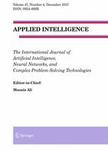版权所有:内蒙古大学图书馆 技术提供:维普资讯• 智图
内蒙古自治区呼和浩特市赛罕区大学西街235号 邮编: 010021

作者机构:Anhui Univ Sch Math Sci Hefei 230601 Anhui Peoples R China Nanjing Univ Informat Sci & Technol China Inst Mfg Dev Nanjing 210044 Jiangsu Peoples R China Anhui Univ Sch Econ Hefei 230601 Anhui Peoples R China
出 版 物:《APPLIED INTELLIGENCE》 (应用智能)
年 卷 期:2020年第50卷第1期
页 面:222-240页
核心收录:
学科分类:08[工学] 0812[工学-计算机科学与技术(可授工学、理学学位)]
基 金:National Natural Science Foundation of China [71771001, 71701001, 71871001, 71501002] Natural Science Foundation for Distinguished Young Scholars of Anhui Province [1908085 J03] Research Funding Project of Academic and technical leaders and reserve candidates in Anhui Province [2018H179] Provincial Natural Science Research Project of Anhui Colleges [KJ2015A379, KJ2017A026]
主 题:Decision making Hesitant fuzzy linguistic preference relations Multiplicative consistency Priority vector Integer programming model
摘 要:Hesitant fuzzy linguistic preference relation (HFLPR) as a new preference relation is introduced to express the decision makers (DMs ) hesitant preference information for each pairwise comparison between different alternatives or criteria. In this paper, the priority vector and consistency of HFLPR are discussed based on a two-stage optimization and multiplicative consistency. Based on the original hesitant preference information, the multiplicative consistency index of an HFLPR is defined to measure the consistency level of the HFLPR. For an unacceptable multiplicative consistent HFLPR, a goal programming model, which is an integer optimization model, is developed to derive an acceptable, multiplicative, consistent HFLPR. According to probability sampling, a linguistic preference relation (LPR) with the best consistency level and an LPR with the worst consistency level with regard to an HFLPR are defined. Combining the two LPRs, a two-stage optimization framework is constructed to obtain the HFLPR s priority vector, which considers the DM s risk preference. A multi-stage optimization approach is proposed to solve decision-making problems by integrating the goal programming model and the two-stage optimization framework. Two real life problems are analyzed to show the feasibility of the proposed approach.